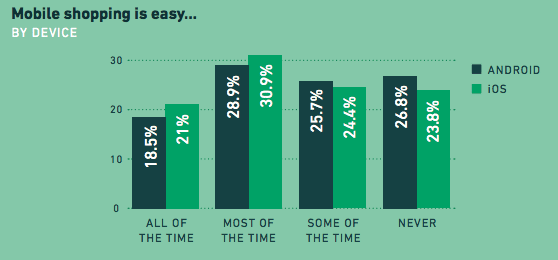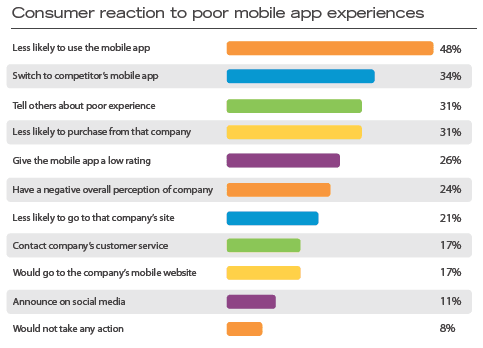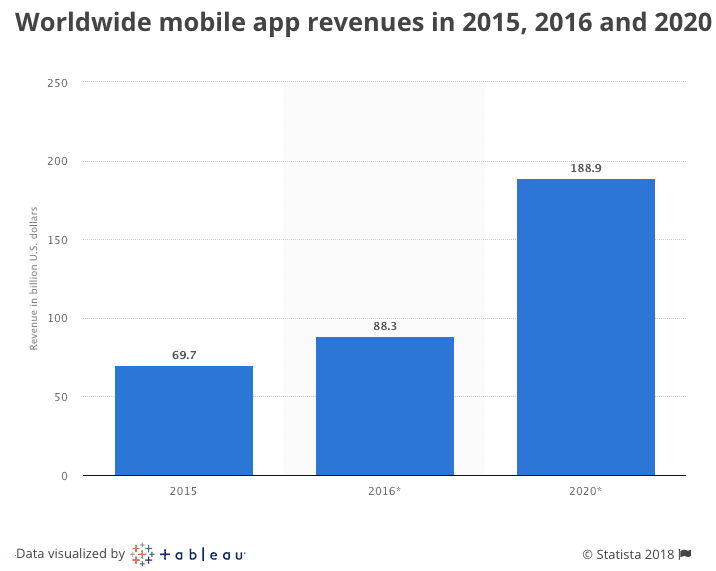There are billions of dollars in the mobile app industry.
So it’s safe to say that there is definitely plenty of money to be made. This is encouraging news if you currently have a mobile app or if you’re thinking about turning your app idea into a reality.
How much money will you make?
Well, the answer to this question greatly depends on a lot of different variables. Your app may not make a billion dollars, but you can access a piece of that pie and still turn a hefty profit.
In order to do so, the first step is mobile app development.
For those of you who already have one, that’s great; you’ve got a head start. Just because your existing app isn’t making money hand over fist, it doesn’t mean that it’s too late to make adjustments.
One of the factors that impacts your revenue is whether you develop for the Google Play Store or Apple App Store.
It also depends on your app monetization models. There are three main ways that mobile apps can make money.
- subscriptions
- in-app purchases
- advertisements
Which app monetization model is right for you? You’ll also have to take into consideration that mobile apps aren’t just for phones anymore. There is an emerging market for additional devices.
In this guide, I’ll cover all of these topics in greater detail. You’ll also learn more about how free apps make money, how paid apps make money, how game apps make money, and more. This will give you a much better understanding of how to make money from your own app or with an app development idea.
Can you make money from apps? Here’s what you need to know.
Become a Buildfire White Label Reseller and make money building mobile apps for your clients
BECOME A BUILDFIRE RESELLER
Which platform makes the most money?
Generally speaking, there are two types of platforms to develop for. You’ve got to decide if you’re building for Apple, Android, or both platforms simultaneously.
So, which app developers make the most? It’s Apple.
25% of Apple developers make over $5,000 per month. Just 16% of Android developers make more than $5,000 each month.
But with that said, Android app developers have a wider audience. That’s because Android dominates the global market share with the Google Play Store.
So the amount of money you make will depend on which one of the platforms you decide to go for first.
Android and iOS users behave differently. So the type of app you have has to fit with the audience that you’re marketing toward and what platform they have the largest presence on.
For example, let’s say you have an existing business that sells products in stores, online through an ecommerce shop, or both.
You may be considering a mobile app as another platform to reach your existing customers as well as a potential new market.
Knowing that there are more Android users than Apple users might make you learn towards developing for Android first. But is that the right decision? Consider the app market.
Studies show that more iOS users find mobile shopping easier than Android users.
In recent years, nearly 47% of iOS users made a purchase from a smartphone. Only about 38% of Android users did the same.
So you’ve got to decide what you want. Would you prefer to have a smaller percentage of a larger population to buy something? Or is it better to have a larger portion of a smaller population?
I’ll talk about this concept in greater detail a bit later on when we discuss the different types of app revenue streams.
But for those of you who haven’t started development yet, one of the first things you need to do is figure out your target market. Don’t make assumptions.
You’ll need to conduct actual research to figure out who will be interested in using your app.
This may seem like a daunting task if you’ve never done it before. But trust me, it’s worth the extra effort. It will save you headaches down the road and make sure that you don’t launch on the wrong platform.
As a result, releasing your app on the right platform will help ensure that you’re making as much money as possible.
Another factor that falls into this category is how your app works. Your mobile application needs to perform well, regardless of which platform you’re building for. For example, let’s say your app is live on Google Play. Users won’t be able to make in-app purchases if it’s buggy and always crashing.
For those of you who already have a live app, you may want to take a look at its performance to see if there are any issues that could be hindering your profits.
If users have a bad experience with your app, they are more likely to abandon it.
What are some of the things that cause a poor experience? For starters, if your app takes a long time to load, users won’t stand for it.
The expected load time for a mobile app is 2 seconds. Furthermore, only 16% of users will try to load an app more than twice if it fails on them.
So no matter what platform (Google Play vs. App Store) your app is on, you’ve got to prioritize how it works and enhance the user experience if you want to make lots of money.
What kind of revenue do they make?
So how much money are we talking about here?
Well, besides the platform, the type of revenue that an app makes will largely depend on the monetization strategy, which we will cover in greater detail shortly.
Looking past the revenue model and the audience, I want to share with you some industry averages and projections.
This will help you better understand how much apps make right now and what they will make in the future.
Consider what type of app you’re building. Is it a game? According to Statista, the leading app publisher for mobile games across the world in 2017 was Netmarble Games.
In September 2017, they generated $58.47 million on the Google Play Store from their games.
As for non-gaming applications, in October 2017 the LINE Corporation made roughly $11.79 million from apps installed on Android devices.
In addition to the LINE Corporation, some of the other leaders in revenue from non-gaming apps include the Kakao Corporation and Tinder.
So what can you do with this information? It shows that there is a drastic difference in revenue based on the type of app that’s in question.
While the top games make more money than non-gaming apps, it doesn’t necessarily mean that you need to create a game to be successful.
In fact, you may even have some trouble in this space unless your game is a top hit. There’s so much competition in the gaming world so it could be tough for you to compete with the industry leaders.
But there is still plenty of money to be made even if you’re not launching a gaming app. Take a look back at those numbers.
Industry leaders are still making millions of dollars on a monthly basis from just one platform.
Take a look at the future projections for mobile app revenue worldwide in the coming years.
The total projected revenue in 2020 is more than double the global revenue from 2016. So the mobile app industry is showing no signs of slowing down at any point in the near future.
This means that the industry leaders will continue to make more money, but new apps also have a chance to get a piece of the action as well.
Build a profitable mobile app in less time and at a lower cost than traditional solutions with BuildFire
GET STARTED WITH BUILDFIRE
Types of revenue streams (app monetization strategies)
Part of deciding what type of app you’re going to make is figuring out how you’re going to make money. This is the most important decision about the type of app you’re building.
Why?
Your strategy to make money can change the entire point of your app.
Here’s what I mean. You could have a really cool idea for a mobile application. So you start to take the right steps to build your app.
But one of the first steps has to be a business plan. Your app may be able to entertain an audience or even make their life easier, but that’s useless if it can’t make you any money.
So you may have to go back to the drawing board and rework your entire concept based on the type of revenue stream you want to pursue.
Some of you may have realized this after your app was already launched. Fortunately for you, it’s not too late to make an adjustment.
But for the rest of you, it’s definitely much easier to get this squared away before your app launches in the app store.
Subscriptions, in-app purchases, and advertisements are the top three ways to make money with an app. You’ll have to decide which one works best for your idea.
You could potentially even use a combination of these methods. Businesses can make money from mobile applications without charging for downloads. I’ll show you how to make money with a free app using the following methods:
Subscriptions
The concept of subscriptions is pretty straightforward.
You charge users a rate for a specific period of time. Monthly and annual subscriptions are the most common ways to approach this type of revenue.
Let’s look at an example. Lumosity is an app that helps train your brain with games.
Here is their listing in the Apple App Store. As you can see, this is a free app. However, they charge various monthly rates for different subscription packages and in-app purchases.
Users can pay $11.99 per month or $79.99 per year.
It’s a great way to make money. In fact, a recent study showed that subscription based apps make 50% more money per user compared to apps with other types of in-app purchases.
These types of apps typically make two or three times more money than apps that use advertisements or paid downloads to turn a profit.
But if your app relies on subscriptions, you absolutely need to create content that keeps people coming back for more.
Users aren’t going to pay you a fixed monthly fee for an app that they never use. You may get some people to sign up initially, but they’ll just cancel after a month or two if it’s not keeping them engaged.
The best way to make the most money with a subscription app is by targeting a big audience. You don’t have to charge a huge monthly or annual fee if you think you can get enough people to subscribe.
It’s important for you to have a creative team that’s always working to improve your app and keeps it relevant for your subscribers.
That way the content won’t get stale and people will continue to pay for the services.
Purchases
As I briefly discussed earlier, if you’ve got an existing business that sells products or services, a mobile app can help you make more money.
While directly providing users with a product or service may be a very viable way of earning money, you’ve got to factor in your marketing, pricing, and logistics.
This tends to complicate things a little bit. For example, if you’re shipping a physical product to users who buy something from your app, you’ve got to make sure that the sale is still profitable after shipping, packaging, labor, and all the other costs associated with running your app.
Another way to make money through in-app purchases is by providing users with something intangible that can be used within the app. Free mobile apps or freemium apps target app users with premium features.
Gaming apps use this strategy all of the time to generate profits.
Here’s an example from the Pokemon Go app.
This is another free app to download.. Throughout the gameplay, users can do certain things to earn coins. These coins can be used to purchase items that enhance the gameplay.
But rather than completing those tasks to earn coins, you can purchase them with real money.
It’s a great strategy to make money because it’s not costing you anything extra to provide these intangible coins. This is drastically different than shipping an actual product. There’s tons of money to be made with free apps.
Advertising
Just like a website, in-app advertising is a popular way of earning money. The Weather Channel app uses this monetization strategy.
But in order to do this effectively, you’ve got to take time to research your users. To get the most money you’ll need to align your ads with products and services that they actually need.
Displaying ads for women’s perfume on a college boy’s device is a waste of space and won’t get you any money.
You’ve also got to tread carefully with this approach. You don’t want to bombard your users with too many ads to the point where it hinders their experience.
Apps need to be displayed at the right time to be effective. Otherwise it can be perceived as spam. Overall, advertising is still a great way to monetize free apps without in-app purchases in the app store.
When users download a paid app, they don’t expect to see ads. But ads on. a free mobile app are more acceptable. Alternatively, you can you can pair your advertising strategy with a subscription model. Have a free app version with in app ads and a paid app with ads removed.
Do Free Apps Make Money?
This is one of the most common questions I hear on a regular basis. To keep it short, yes, free mobile apps make money. You just need to apply a free app monetization strategy.
Mobile apps don’t need to be complicated to be profitable. You can build a free app and monetize it using any of the strategies listed above. In fact, free apps make up the vast majority of applications available on the market today. Those development companies still make money using in-app purchases and other monetization methods.
Whether you’re using in-app purchases or another business model, you can follow their lead and still make money with free apps.
Future of development
Today you’ve got to think outside of the box when it comes to mobile app development. Apps are no longer just for smartphones and tablets. Again, look at the app market.
Smart TVs are on the rise in the United States.
As of November 2017, nearly 70 million households in the United States have a smart TV.
Companies who offer streaming services promote the availability of their apps on these devices.
Directly from their TVs, users can access apps such as:
- YouTube
- Hulu
- Netflix
- HBO Now
- Watch ESPN
- Amazon Video
There are also apps available for video game consoles like PlayStation4, Xbox One, and Wii U. All of these devices have app stores built into the system.
There is even a growing market for novelty apps and productivity apps. These are less complex, which means it’s easier to build and maintain.
As a result, profit margins can be much higher.
Conclusion
There is definitely plenty of money to be made with mobile applications. Even free apps make money.
Lots of factors play a role in how much money your app can make. It depends on the platform, the type of app, and your revenue strategy.
Approaching this alone can be intimidating, especially if you’ve never done this before. Free apps can still make money.
The technology involved in creating a mobile app might be overwhelming. You don’t want to waste time or money if you’re unsure of how to efficiently spend and use your resources.
If you need some help along the way, there are plenty of online resources that can put their experience to work for you.
What type of revenue strategy will you use to make the most money with your mobile app?






